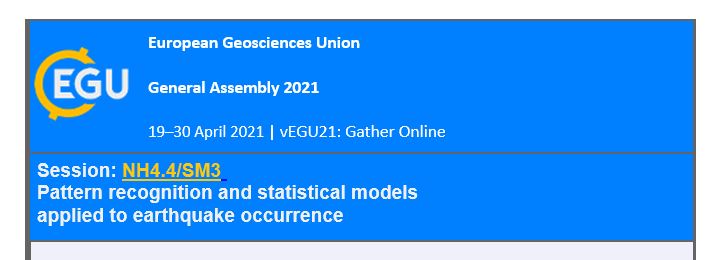Session: NH4.4/SM3 Pattern recognition and statistical models applied to earthquake occurrence
Dear colleague,
We would like to cordially invite you to submit an abstract to the session that we are organizing, which, as in previous EGU Assemblies, focuses on the statistical analysis of earthquake occurrence.
Once again, the European Geosciences Union General Assembly will be held online, branded as #vEGU21: Engage • Discover • Inspire.
EGU will have lower registration fees.
All sessions will run in the new EGU virtual PICO session format, which will offer the opportunity to address a truly worldwide and diverse audience.
Abstract submission deadline: 20 January 2021, 13:00 CET (12:00 UTC)
Best wishes from the conveners:
Stefania Gentili
Rita Di Giovambattista
Álvaro González
Filippos Vallianatos
Session description
New models based on seismicity patterns, considering their physical meaning and their statistical significance, shed light on the preparation process of large earthquakes and on the evolution in time and space of clustered seismicity.
Opportunities for improved model testing are being opened by the increasing amount of earthquake data available on local to global scales, together with accurate assessments of the catalogues’ reliability in terms of location precision, magnitude of completeness and coherence in magnitude determination.
Moreover, it is possible to reliably integrate the models with additional information, like geodetic deformation, active fault data, source parameters of previously recorded seismicity, fluid contents, tomographic information, or laboratory and numerical experiments of rock fracture and friction. Such integration allows a detailed description of the system and hopefully an improved forecasting of the future distribution of seismicity in space, time and magnitude.
In this session, we invite researchers to submit their latest results and insights on the physical and statistical models and machine learning approaches for the space, time and magnitude evolution of earthquake sequences. Particular emphasis will be placed on:
• Physical and statistical models of earthquake occurrence
• Analysis of earthquake clustering
• Spatial, temporal and magnitude properties of earthquake statistics
• Quantitative testing of earthquake occurrence models
• Reliability of earthquake catalogues
• Time-dependent hazard assessment
• Methods for earthquake forecasting
• Data analyses and requirements for model testing
• Pattern recognition in seismology
• Machine learning applied to seismic data
- Uncertainty quantification methods for pattern recognition and machine learning approaches.


Recent Comments